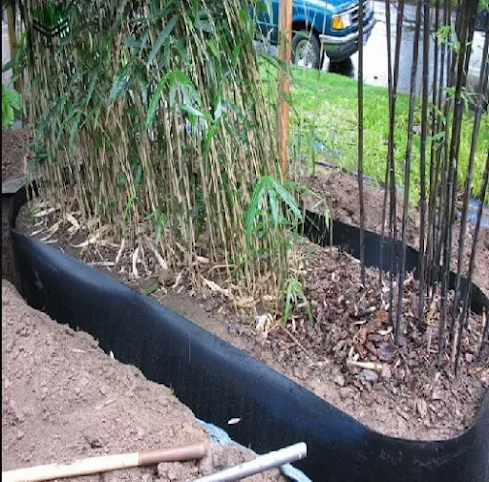Trees are majestic additions to any landscape, providing shade, beauty, and environmental benefits. However, their expansive root systems can sometimes become unwelcome guests, threatening foundations, pavements, and underground utilities. This is where root barriers emerge as heroes, offering root barrier for trees and harmony between your beloved trees and your precious infrastructure.
At Singhal Industries Pvt Ltd, we understand the unique challenges posed by tree roots. That's why we offer a diverse range of high-quality root barrier solutions designed to protect your landscape while promoting healthy tree growth. But navigating the diverse options can be confusing. So, let's explore the exciting world of root barrier sheet and guide you towards choosing the perfect fit for your needs:
Understanding the Types:
Physical Barriers: These are the most common type, forming a continuous underground wall to redirect roots. Popular options include:
- HDPE (High-Density Polyethylene) Sheets: Durable, versatile, and cost-effective, ideal for most applications.
- Steel Mesh: Offers superior strength and rigidity, suitable for high-risk situations like protecting foundations.
- Gabions: Stone-filled baskets creating a robust barrier, often used for retaining walls and slope stabilization.
Chemical Barriers: These utilize chemical compounds to deter root growth in designated areas. However, their use requires careful consideration due to potential environmental concerns.
Root Pruning Barriers: These allow controlled root growth while preventing them from reaching undesired areas. Options include:
- Vertical Root Guides: Channels roots downwards, ideal for protecting pavements and driveways.
- Root Pouches: Encourage downward growth within a contained space, suitable for containerized trees.
Choosing the Right Fit:
Several factors influence your choice:
- Tree Species: Consider the aggressiveness of the root system (shallow vs. deep, fast vs. slow-growing).
- Protection Needs: Identify what you want to safeguard - foundations, pipes, walkways, etc.
- Soil Conditions: Different barriers perform better in specific soil types (clay, sand, etc.).
- Budget and Durability: Consider the initial cost and expected lifespan of the barrier.
- Sustainability: Opt for eco-friendly materials and responsible manufacturing practices.
Singhal Industries - Manufacturer of Flexible Packaging Product
We go beyond just offering diverse root barrier options. We provide:
- Expert guidance: Our team helps you assess your specific needs and recommend the ideal solution.
- High-quality materials: We ensure durability, performance, and minimal environmental impact.
- Customizable solutions: We cater to unique project requirements with tailored barrier configurations.
- Sustainable practices: We promote responsible manufacturing and eco-friendly materials.
Beyond Protection:
Remember, tree root barrier are not intended to harm trees. They promote healthy growth by guiding roots where they belong, fostering a harmonious coexistence between your trees and your landscape.
Join the Root Barrier Revolution:
Protect your precious infrastructure while nurturing your beloved trees. Explore Singhal Industries' Pvt Ltd's range of root barrier solutions and discover the peace of mind and tranquility they bring to your landscape.
frequently asked questions (FAQs) about Finding the Perfect Fit: Protecting Your Landscape: Choosing the Right Root Barrier for Your Trees:
Q1: What is a root barrier, and why is it important for trees?
A1: Understand the purpose of root barriers, which are physical barriers installed underground to control the growth of tree roots and protect structures, utilities, and landscapes from damage. Q2: What types of root barriers are available for trees?
A2: Explore different options such as rigid plastic barriers, flexible membranes, geotextile fabrics, and metal barriers, each offering unique benefits and applications for tree root management. Q3: How do I determine the right size and depth of a root barrier for my trees?
A3: Learn about factors like tree species, root spread, soil type, and proximity to structures when selecting the appropriate dimensions and installation depth for a root barrier. Q4: Are there specific installation techniques for root barriers?
A4: Discover best practices for installing root barriers, including trenching methods, barrier placement, backfilling procedures, and sealing techniques to ensure effective root containment. Q5: How long do root barriers last, and do they require maintenance?
A5: Understand the lifespan of root barriers and considerations for periodic inspections, repairs, and replacements to maintain their integrity and effectiveness over time. Q6: Can root barriers harm trees or affect their health?
A6: Address concerns about potential impacts of root barriers on tree health, such as root constriction, soil compaction, and water drainage, and learn how to mitigate these risks through proper installation and maintenance practices. Q7: Are there environmentally friendly options for root barriers?
A7: Explore sustainable alternatives to traditional root barriers, including biodegradable materials, recycled products, and permeable barriers designed to minimize ecological impact while providing effective root control.

Comments
Post a Comment